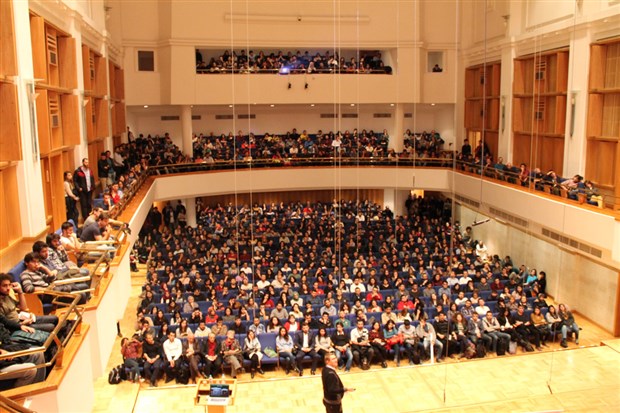 Dr. Umut Yıldız, a postdoctoral researcher at NASA’s Caltech-affiliated Jet Propulsion Lab, spoke last Tuesday to an eager Bilkent audience on the formation of stars, NASA’s past and future planetary excursions, and how monitoring space may allow us to better understand our own ecosystem. The talk was organized by İnovatif İnternet Topluluğu, a Bilkent student club.
Dr. Umut Yıldız, a postdoctoral researcher at NASA’s Caltech-affiliated Jet Propulsion Lab, spoke last Tuesday to an eager Bilkent audience on the formation of stars, NASA’s past and future planetary excursions, and how monitoring space may allow us to better understand our own ecosystem. The talk was organized by İnovatif İnternet Topluluğu, a Bilkent student club.
Dr. Yıldız’s own research concerns the formation of stars and the expulsion of matter that occurs during this process, and his lecture began with an account of the million-year saga that starts with the gravitational collapse of a nebular gas cloud and ends with the birth of a brand-new star—and also features a curious epoch where carbon compounds and water are formed and ejected at breakneck speeds out of the embryonic star’s poles. Invisible to the naked eye, these events can only be observed through infrared imaging, which is able to penetrate the layers of space dust that obscure the inner workings of nebulae and the proto-stars they host.
Moving on to a more earthly topic, Dr. Yıldız discussed the terrestrial and space telescopes that render such research possible, including both stand-alone equipment such as Hubble and the jet-bound SOFIA, and array-based telescopes such as LOFAR and the Square Kilometer Array. While land-based telescopes are limited by Earth’s atmosphere, small telescopes on planes and air balloons are able to largely ignore these constraints, and the necessity of building large and cumbersome telescopes for increased sensitivity can be avoided by utilizing large arrays of radio antennae that pool their data to effectively become kilometer-long telescopes. These systems are useful not only for observing stellar objects but also for gathering large-scale data about Earth’s own soil and air.
The last topic of the talk concerned NASA’s bigger plans, which revolve around finding bacterial life on other planets, or putting human life there. Theories abound regarding the possibility of bacterial life having existed (or even still existing) on other planets and moons, and new and experimental designs are now being advanced to explore such strange locales as Mars’s paper-thin atmosphere (the monitoring of which may allow informed decisions on the landing places of forthcoming probes) and Europa’s sub-glacial ocean (which is regarded as one of the most likely places for life to evolve). However, Dr. Yıldız also cautioned against the possibility of contaminating another planet with Earth’s own bacterial fauna—which are tough enough to endure launch and reentry, so that there is a serious risk of their surviving on a rover and being mistaken for truly alien organisms.
